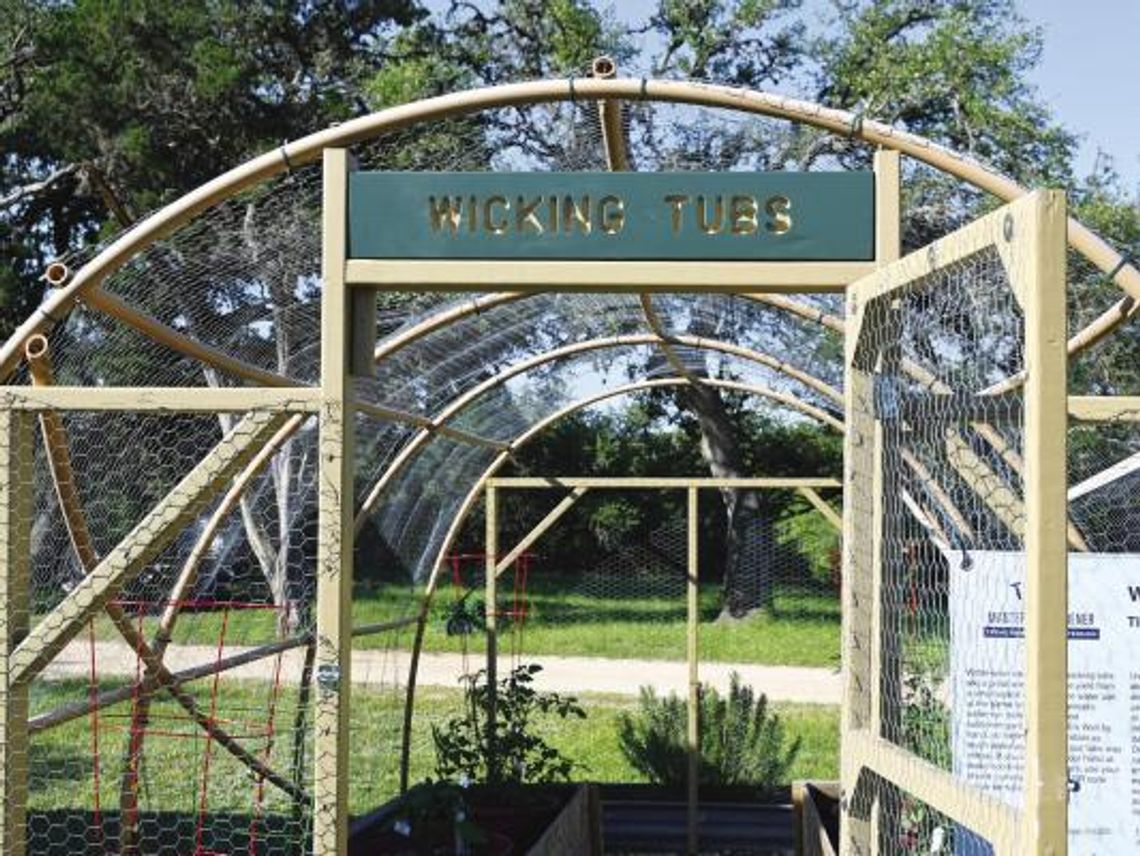Never ones to undervalue the gifts of Mother Earth, the Hays County Master Gardeners hosted an open-house event this past weekend to commemorate Earth Day.
The event took place on Saturday, April 22 at Jacob’s Well Natural Area. On display to visitors were the recently completed Raised Bed Information Garden and the Wicking Tub Garden, as well as the HCMG Greenhouse and Demonstration Garden. Coffee and pastries were offered to visitors while docents led tours explaining the processes at work in each of the projects.
Raised bed options using different materials defined the purpose of the Raised Bed Garden near the greenhouse. The gated and screened area was built by lead project manager James Du-Bose with the help of Master Gardener volunteers. Raised beds made from repurposed garden timbers, manufactured panels, galvanized tanks, plastic tubs and reclaimed wood were on display, including a bed made from downed timbers from the recent ice storm stacked into a rectangle, lined with plastic and recently planted with beans.
HCMG Vice President Josh Shuster, a docent for the event, explained that “gardeners in the Hill Country with shallow soil deposits can see that you don’t need a lot of space or the best soil to grow a successful garden.”
Varieties of tomatoes, as well as peppers, beans, broccoli and other vegetables were thriving in the assorted beds.
“This part of the Jacob’s Well Natural Area was an old RV park,” Shuster continued. “We can’t dig into the ground because we don’t know what lines are buried underneath the surface here. For that reason, we enthusiastically embraced this project for its teaching and practical problem-solving aspects.”
Volunteer and wife of the project lead, Tracy DuBose, showed visitors “ollas” buried in the raised beds. “Ollas,” a Spanish word for traditional clay water storage pots, have evolved for gardeners into specialized vessels designed to be buried in raised beds.
“The pots are kept filled with water that slowly seeps out and keeps the soil moist,” DuBose said. “It also supports the design of raised beds in that it encourages roots to grow down instead of out — which creates a plant that is better supported and nourished.”
Adjacent to the greenhouse was the Wicking Tub enclosure, where lead project manager Trish Rigdon was showing visitors how a wicking system worked.
“A length of perforated flexible tubing used in French drains with permeable material affixed to each end is placed at the bottom of a large tub,” Rigdon explained. “A vertical riser is attached to the tubing, so once the tub is filled with soil and planted, water can slide down the riser to the bottom of the tube where it is slowly released.”
One of the major advantages of the wicking system is the conservation of water. Top ground watering is less effective than wicking systems because of runoff and evaporation, according to Rigdon. Like the buried olla, this method encourages roots to grow downward.
Staffing an information table with flyers and bundles of seeds hand harvested and packaged in a recent seed swap were Dripping Springs Farmers Market information table lead Cheryl Jackson and volunteers Susanne Howell and Bud Sartain.
“We have had so much new interest in our program and materials that we have expanded our presence in Dripping Springs,” Jackson said.
A discussion among volunteers as to the reasons for the burgeoning interest took place and whether the reasons were from population growth or a result of recent weather events, Master Gardener Marilyn McCray said that “Whatever the reason, it is so important to know exactly what to do where you live.”
The Master Gardener information tables offer easy-to-understand instructional materials published by Texas A&M University. These address a range of subjects, including native plant selection, planting calendars, pollinator species, pest and weed control, water collection systems and other information for gardeners in the central Texas region. Some of the material is even adapted for children.
Shuster explained that “Sharing information with the public at information tables is an effective way to cement newly acquired knowledge and experience.”
“Plus,” he continued, “it allows people curious to know more about the program a way to meet others who have recently completed their training.”
It also provides a forum for the exchange of tips from veteran gardeners — those often eager to share their experience, successes and problems with others.
Built in 2018, the HCMG greenhouse is a substantial teaching tool and resource for gardeners training for Master Gardener credentials. Recently refurbished in January, the cedar greenhouse, built in keeping with the park’s aesthetics, features 12 large windows, a pea gravel floor with buried plumbing, thermostatically controlled exhaust fans, a rainwater collection system and automatically controlled zone irrigation. Solar screens were installed in February to help control summer heat in the structure that can rise well above 110 degrees.
Past HCMG president Connie Wierman said the greenhouse is an important part of their program.
“Not only is it a teaching facility and workshop for our membership, but the greenhouse also allows us to start plants for the gardens,” Wierman said. “Each year, we hold a plant and tree sale, and during that event, we use the greenhouse to house and maintain the plants before they’re sold. In the future, we hope to use it for seed swaps.”
Michelle Burgess, Demonstration Garden lead, showed visitors the beds that are maintained by the HCMGs in partnership with the Hays County Parks Department. Planted with native and adapted perennials, the garden displays varieties that perform well and attract pollinators to the garden.
“Volunteering at the Demonstration Gardens is a wonderful Saturday morning activity. Members gather one or two Saturdays a month to work in the garden and we invite the community to chat with us as we work. We’re always happy to exchange information,” Burgess said.
Hays County Master Gardeners train in a 11-week course taught by Texas A&M AgriLife Extension Service specialists, staff, and local experts. The courses follow Earth-Kind practices of landscape management covering soil and plant nutrition, insect, disease and weed management, tree care and vegetable and herb gardening. It also teaches lawn care, plant selection, composting and water conservation. Field trips support the classroom training when possible.
To earn Master Gardener credentials, students must complete 64 hours of training and 50 hours of volunteer work. Following a recent decision, ten of the 50 hours must now include staffing information tables at farmers markets, libraries and other public locations.
To learn more about the Master Gardener program, visit hayscountymastergarden-ers. org.







